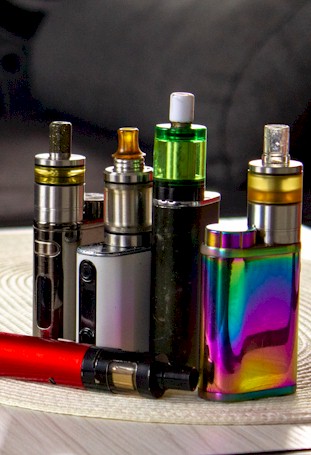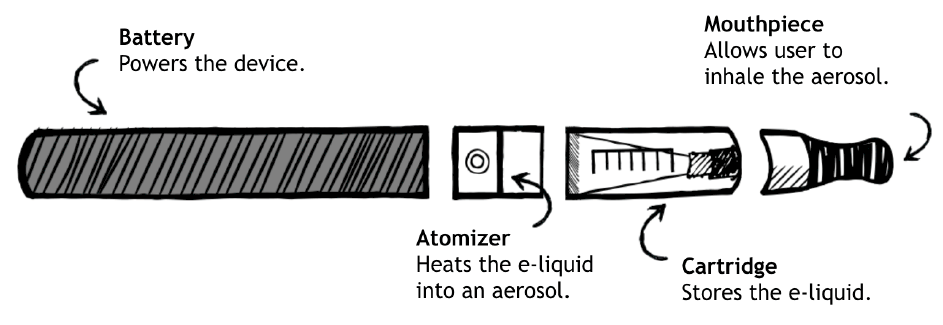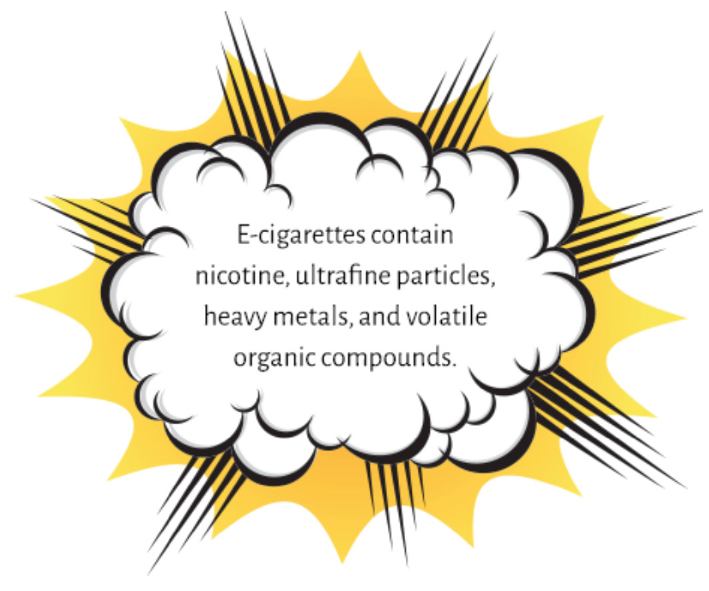Lesson 12
Lesson 20 Module 5
Nicotine and Potential Problems in Babies
Besides being born too early and too small, newborns of young women who smoke/use tobacco while pregnant are also at increased risk for:
• infant death
• birth defects such as cleft lip
• heart problems
• Sudden Infant Death Syndrome (SIDS)
• all types of cardio-respiratory issues like asthma, bronchitis, and pneumonia (7)
In later childhood and adolescence, children prenatally exposed to tobacco/nicotine have been found to have problems with hearing and processing language that negatively affect their school achievement.

Did You Know:
Some studies suggest that children of women who smoke have an increased risk of being diagnosed with Attention Deficit Hyperactivity Disorder. (8,9)
Nicotine and Development
So tobacco use during pregnancy is a serious issue, right? What about vaping of tobacco
products during pregnancy? Is that somehow safer? What do we know about vaping versus smoking traditional cigarettes?
E-cigarette use poses a significant – and avoidable – health risk to young people in the United States. Besides increasing the possibility of addiction and long-term harm to brain development and respiratory health, e-cigarette use is associated with the use of other tobacco products that can do even more damage to the body. Even breathing e-cigarette aerosol that someone else has exhaled poses potential health risks.
Sound familiar? Didn’t we just discuss these same issues when we talked about tobacco and nicotine?

Next let’s try a short quiz and see what you know about vaping and e-cigarettes.

Discuss:
Are you exposed to a lot of advertising for e-cigarettes or vape pens? What are some of the
claims that those ads make?
Quiz
The U.S. Surgeon General, Centers for Disease Control and Prevention, and the U.S. Department of Health and Human Services have a great resource on vaping and e-cigarettes called “Know the Risks.” (10)
Let’s take a look at their 5-question quiz about vaping and e-cigarettes:
1. More than 6 of 10 youth and young adults believe that occasional use of e-cigarettes causes only little or some harm.
A.) True
B.) False
2. Which of the following is a risk to youth and young adults who use nicotine?
A.) Depression, anxiety, and other mood disorders
B.) Nicotine addiction
C.) Difficulty paying attention and concentrating
D.) Reduced impulse control
E.) All of the above
3. Your brain continues to develop until about which age?
A.) 12
B.) 18
C.) 21
D.) 25
E.) 30
4. Which of these tobacco products is most commonly used by U.S. high school students?
A.) Cigarettes
B.) E-cigarettes
C.) Little cigars
D.) Hookah
5. Which of the following are reasons young adults use e-cigarettes?
A.) Availability of e-cigarettes in candy, fruit, and alcohol flavors
B.) Belief that e-cigarettes are safe
C.) Curiosity
D.) All of the above
Answers:
1) A.
2) E.
3) D.
4) B.
5) D
How an E-cigarette Works
Before we wrap up this part about smoking, nicotine, and vaping/e-cigarettes, let’s take a quick look at how an e-cigarette actually works.
Below you’ll see the parts that make up most vape pens or electronic cigarettes.
There is a battery, which powers the device. Then there is an atomizer, that heats the e-liquid at such a high heat the liquid becomes an aerosol.
There is also a cartridge that stores the e-liquid that will be aerosolized.
And finally, of course, there is a mouthpiece that allows you to inhale the aerosolized nicotine or THC or other liquid you have added to the cartridge.

(10)
Did You Know:
Doctors recommend that pregnant women avoid all nicotine products including cigarettes, e-cigarettes, and smokeless tobacco (for example, snus, dip, or chewing tobacco).
Harmful Chemicals in E-cigarettes
The aerosol from e-cigarettes is not harmless. It can contain harmful chemicals including nicotine; ultrafine particles that can be inhaled deep into the lungs; flavoring such as diacetyl, a chemical linked to a serious lung disease; volatile organic compounds such as benzene, which is found in car exhaust; and heavy metals, such as nickel, tin, and lead. (11)
Scientists are still working to more fully understand the health effects and harmful doses of e-cigarette contents when they are heated and turned into an aerosol, both for active users who inhale from a device and for those who are exposed to the aerosol secondhand. Another risk involves defective e-cigarette batteries that have been known to cause fires and explosions, some of which have resulted in serious injuries. Most of the explosions happened when the e-cigarette batteries were being charged, but have also happend when people were using the device. (11,12)
• Are you surprised about this information about vaping, nicotine, and e-cigarettes?
• What questions do you have about nicotine, tobacco, or vaping/e-cigarettes?
• Do you see a lot of advertisements for e-cigarettes on social media?
• Have you heard about all the recent incidents of serious lung illnesses in young adults who have been vaping?

(11)